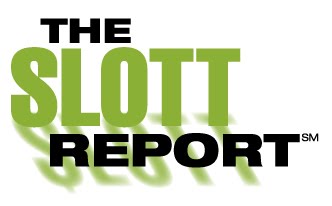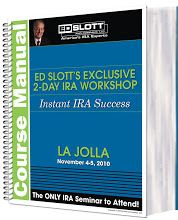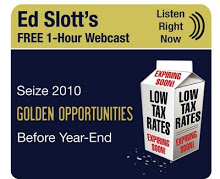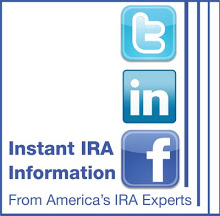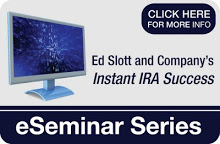Friday, October 30, 2009
Discussion Forum Question: WRERA and 2008 Beneficiaries
In general, when an IRA owner dies, the designated beneficiaries (if there are any) must begin taking minimum distributions (RMDs) by December 31st of the year following the year that the IRA owner died. For example, if John died in February of 2009, his beneficiaries could wait all the way until December 31st of 2010 to take their first distribution and use the "stretch."
But in late 2008, Congress passed the Worker, Retiree and Employment Recovery Act (WRERA). In that law, the RMDs for IRAs and some company plans were suspended for account owners and beneficiaries alike.
So what happens if you inherited an IRA in 2008? What year do you start taking distributions and how are they calculated?
Well, the first part is actually pretty easy. If you inherited an IRA in 2008, you would normally have to start taking distributions in 2009 (no later than December 31st). But there are no distributions required for this year, so......just start next year. See, I told you that part would be easy!
The calculation of the RMD is a little trickier though. Even though distributions wouldn't start until next year, you actually have to calculate them as if they did start this year. Basically, we just pretend WRERA and the suspension never existed.
For example, if you turned 45 in 2008 and inherited an IRA, you would normally use age 46 (the age you turn in the year of your first required distribution) to look-up the "factor" on the Single Life Table for determining your distribution. For a 46 year old, the life expectancy factor is 37.9. Each year, you would subtract one to get the new factor. So, in our example, the second year's factor (2010) would be 36.9 (37.9-1), in 20011 it would be 35.9, and so forth. Well, since for next year's (2010) calculation we're going to pretend like the suspension never happened, you would still use 36.9 as the factor, just as you normally would have needed to.
Not too bad, but a little more complicated, right? And this is the "easy" stuff! If you need to calculate an RMD or have other important questions, it's always best to speak with a professional who specializes in this are. Remember, IRAs are different and it takes a different kind of knowledge.
Have more questions? Want to see what other people are asking? Check out the Ed Slott and Company IRA Discussion Forum.
By IRA Technical Consultant Jeffrey Levine and Jared Trexler
------------------------------------------------------------------------------
Comment, Question, Discussion Topic on your mind? Click on the Blue Comment Link below and leave your thoughts then check back to see what other consumers and advisors think.
*Copyright 2009 Ed Slott and Company, LLC
Quality content
- Siti Non Aams
- Nuovi Siti Casino
- Casino Non Aams Italia
- Casinos Not On Gamstop
- Casino Sites Not On Gamstop
- Online Casino
- UK Casino Not On Gamstop
- Sites Not On Gamstop
- Casino En Ligne
- Casino En Ligne Fiable
- Casinos Not On Gamstop
- UK Casino Not On Gamstop
- Casino Sites Not On Gamstop
- Non Gamstop Casinos UK
- Casino Online Non Aams
- Casino Not On Gamstop
- Meilleur Casino En Ligne France
- Casino Sites Not On Gamstop
- Non Gamstop Casino Sites UK
- Casino Sites UK Not On Gamstop
Thursday, October 29, 2009
Slott Report Mailbag: October 29
1.
The October 15th issue of the New York Times -- page 2 of the Retirement Section -- featured an article regarding Roth IRAs in which the author stated that withdrawals from a Roth (whether started by a conversion or annual contributions) would be taxable during the first 5 years following the creation:
- Is this true?
- Would this rule apply to someone who was already making the mandatory withdrawals from his IRA effective 2008 (current age 72) and then converted to a Roth in 2010?
- Is there a mandatory withdrawal requirement for a Roth, and if so, how is the withdrawal amount calculated?
Distributions from Roth IRAs are not considered taxable income. The five year rule applies to a distribution of earnings before the five year period is up. Distributions are considered first from contributions or conversions and earnings would be the last dollars taken out. You would have already paid the income tax on the money contributed or converted.
The only mandatory withdrawals from a Roth IRA are from an inherited Roth IRA. The original owner will never have any required minimum distributions from a Roth IRA. There are, however, mandatory distributions for beneficiaries of Roth IRAs commencing one year after the death of the original owner. They are based on the life expectancy of the beneficiary. The distribution to the beneficiary is income tax free. The five year rule will still apply but it would only apply to the earnings which will come out last.
2.
Can I make IRA contributions in the same year that I was laid off given that I already contributed some money into a 401(k) plan?
Answer:
Yes, you can contribute to an IRA in addition to contributing to a 401(k) plan so long as you have earned income. The maximum amount you can contribute in 2009 is $5,000. If you are over age 50 or older by 12/31/2009 you can add an additional $1,000. If your earned income is less than $6,000, you can only contribute up to the amount of your income.
3.
I am uncertain as to the timing of a Roth conversion of a small SEP IRA then the rollover of a large 401(k) account into a traditional rollover IRA. If an individual has an IRA that she wants to convert to a Roth in 2010, but she subsequently in the same year receives a rollover distribution to a new traditional rollover IRA from her 401(k) plan, will the newly created rollover IRA be counted in the formula for taxes on the conversion to the Roth IRA because at year end she has a newly created rollover IRA and a Roth IRA? If so, I assume that the terminated employee should just wait until the following year to roll over her 401(k) plan assets to a traditional rollover IRA. She cannot afford to pay taxes on the larger IRA for conversion purposes?
Answer:
The only retirement funds that are taxable are those that are withdrawn and not rolled over within 60 days and those that are converted to a Roth IRA. There is no requirement that all IRAs be converted in one year or even that you must convert an entire IRA. You can do partial conversions. In your example, only the SEP IRA balance would be taxed, as long as the entire 401(k) balance is rolled over to an IRA.
By IRA Technical Consultant Marvin Rotenberg and Jared Trexler
------------------------------------------------------------------------------
Comment, Question, Discussion Topic on your mind? Click on the Blue Comment Link below and leave your thoughts then check back to see what other consumers and advisors think.
*Copyright 2009 Ed Slott and Company, LLC
Upcoming 2-Day IRA Workshop, Instant IRA Success
NEW 2010 Roth Conversion Planning will be discussed at length during Instant IRA Success -- a 2-day foundational program with core IRA education and the latest changes to IRA tax laws.
CLICK HERE for more information to register before next week's workshop.
Tuesday, October 27, 2009
Roth Conversions: Is It For Me?
On the emotional side, you have to be able to come to terms with the fact that you will be paying a substantial amount of income tax that you would normally defer for a number of years. You may have to liquidate assets in order to pay the income tax that you ordinarily would hold on to. Ultimately, what you are doing is paying the income tax for your beneficiaries.
The question I am getting frequently is "What software or calculator should I use to help me determine whether or not I should do a Roth conversion?" There are calculators on the Internet, but they often do not take into account all factors that could affect your decision. There are software programs for professionals in the financial services industry that can process more inputs for a comprehensive look at your options. They can be expensive and difficult to use. We have found no "perfect" program out there that can make the decision for you.
You should work with your advisors and tax preparor to determine if a Roth conversion is the right decision for you. Remember, you can always change your mind about the conversion. You have until October 15th of the year after your conversion to do a recharacterization, even if you have already filed your tax return.
By IRA Technical Consultant Beverly DeVeny and Jared Trexler
------------------------------------------------------------------------------
Comment, Question, Discussion Topic on your mind? Click on the Blue Comment Link below and leave your thoughts then check back to see what other consumers and advisors think.
*Copyright 2009 Ed Slott and Company, LLC
Monday, October 26, 2009
Investment News: New ruling re-opens window for taxpayers
Although the distribution requirements were waived for this year, some people were not aware of the tax law change and took distributions anyway. For those who realized the situation within 60 days, the answer was to roll the funds back to an individual retirement account or plan (providing they were eligible) and eliminate the tax bill. Unfortunately, many did not recognize this opportunity until the 60-day window had closed. Though they didn't want to keep the distributions, there apparently was no relief.
CLICK HERE to read the article in its entirety.
Compiled by Ed Slott and Company
------------------------------------------------------------------------------
Comment, Question, Discussion Topic on your mind? Click on the Blue Comment Link below and leave your thoughts then check back to see what other consumers and advisors think.
*Copyright 2009 Ed Slott and Company, LLC
Friday, October 23, 2009
Ed Slott and Company Personalized Pamphlets
What pamphlets are available?
We have five different pamphlets available: 1)Roth Conversions, 2)Roth IRAs, 3)Required Minimum Distributions, 4)Beneficiary Designation Forms and 5)72(t) Payments.
What is inside each pamphlet?
Each pamphlet includes consumer-friendly information, charts and questions to ask a financial advisor. The front of each pamphlet includes an easy-to-understand definition of the topic discussed.
Can these pamphlets be personalized?
Yes. The pamphlets can be personalized with company information on the back cover. Members of Ed Slott's Elite IRA Advisor Group can order pamphlets with the Elite logo and brief description of the membership group also included on the back. All personalization information should be sent to [email protected] after an order is completed.
Can I get samples to review?
Yes. You can review a watermarked sample by e-mailing [email protected] and asking for sample PDFs of the pamphlets.
Compiled by Ed Slott and Company
------------------------------------------------------------------------------
Comment, Question, Discussion Topic on your mind? Click on the Blue Comment Link below and leave your thoughts then check back to see what other consumers and advisors think.
*Copyright 2009 Ed Slott and Company, LLC
Thursday, October 22, 2009
Slott Report Mailbag: October 22nd
1.
Dear Ed and Company,
Is there any tax advantage of converting a "non-deductible" IRA to a Roth IRA vs. a traditional deductible IRA to a Roth IRA? I'm asking because the non-deductible has "original" cost basis, which is tax-free, and it would seem to make sense to convert as much non-deductible IRA as possible, but only if the conversion implies no taxation. Can you clarify please?
Thanks!
Answer:
You have a good idea - convert a non-deductible IRA to a Roth IRA. Unfortunately it does not work that way unless that is the only IRA you have and all the money in that IRA is non-deductible. There is a little known rule called the "pro-rata rule", which states that when an IRA contains both non-deductible and deductible funds, then each dollar withdrawn or converted from the IRA will contain a percentage of tax free and taxable funds. The same is true even if you have separate IRAs with non-deductible and deductible contributions. All IRAs must be considered for the pro-rata rule, including SEP and SIMPLE IRAs. Bottom line is you cannot just withdraw or convert the non-deductible funds and pay no income tax even if the non-deductible IRA contributions were kept in a separate IRA.
2.
In Bottom Line Retirement, you describe taking company stock from a 401(k) "in kind", also known, I think, as "unrealized net appreciation", whereby you are taxed on the stock's value when the company gave it to you. I am encountering various interpretations of this, can you clarify? My company says that any prior distribution from the plan disqualifies this advantage. The actual wording just says that the entire plan must be rolled over within one calendar year. This means that even a previous RMD would disqualify if my company is right. Even the IRS does not seem to know the answer; talked to them on the phone. Seems to me that whatever is in fund during a taxable year constitutes the entire plan, regardless of a past year partial withdraw. Can you help?
Answer:
It sounds like your company is giving you good advice. If you have low cost basis in your company stock held in your 401(k) plan versus the current market value, using net unrealized appreciation (NUA) could be beneficial. However, the rules regarding NUA are a little tricky. First of all, you need a triggering event, such as separation from service, and the company stock comes out as part of a lump-sum distribution in one tax year to use the NUA advantage. The problem is the definition of a lump-sum distribution. All funds must be withdrawn within one tax year. Distributions in prior years mean that you cannot meet the criteria of doing the withdrawal in one year. If you are 70 1/2 or older and taking required minimum distributions, there would need to be a new triggering event and unfortunately death would be the only triggering event left, assuming you have already separated from service. In that case your heirs would be able to use the NUA advantage.
By IRA Technical Consultant Marvin Rotenberg and Jared Trexler
------------------------------------------------------------------------------
Comment, Question, Discussion Topic on your mind? Click on the Blue Comment Link below and leave your thoughts then check back to see what other consumers and advisors think.
*Copyright 2009 Ed Slott and Company, LLC
Ed Slott's Retirement Decisions Guide
What is Ed Slott's Retirement Decisions Guide?
The Retirement Decisions Guide is a 47-page informational guide for both financial advisors and consumers broken up into 86 ways to save and stretch your wealth. The guide's language is consumer-friendly and the numbered format makes understanding the information much easier.
What are some of the guide's main points?
The guide is broken up into 5 chapters and many times directly points to an online website, http://www.irahelp.com/2010, for updated IRA and tax information. The guide also stresses the point of consumers finding and working with an educated, competent financial advisor. The guide also includes a "Notes" page at the end where you can write down ideas and questions as you read certain sections.
Where can I purchase the guide?
You can CLICK HERE to purchase single copies or copies in bulk of the Retirement Decisions Guide. You can also call our office at 215-557-7022 or e-mail [email protected].
The guide is also available to members of Ed Slott's Elite IRA Advisor Group at a discounted rate at the shopping page found on the Elite section of http://www.irahelp.com./
By Jared Trexler
------------------------------------------------------------------------------
Comment, Question, Discussion Topic on your mind? Click on the Blue Comment Link below and leave your thoughts then check back to see what other consumers and advisors think.
*Copyright 2009 Ed Slott and Company, LLC
Wednesday, October 21, 2009
Marketplace Money: Rollover IRA
Farrell's response: Rollover IRA.
There are no tax consequences as long as the money is transferred from your former employer directly into the rollover IRA account. It is always a good idea to move money, if possible, from an employer plan to an IRA.
As Ed Slott told Farrell: "It's great anytime you can take control of your money and take it out of your company plan."
CLICK HERE to read the entire Q&A section.
By Jared Trexler
------------------------------------------------------------------------------
Comment, Question, Discussion Topic on your mind? Click on the Blue Comment Link below and leave your thoughts then check back to see what other consumers and advisors think.
*Copyright 2009 Ed Slott and Company, LLC
Tuesday, October 20, 2009
Low Inflation Affects Cost of Living Adjustments (COLAs) For 2010
Since the 1980s, many items in the federal tax code have been indexed for inflation each year. More than 50 deductions, exemptions or exclusion amounts are adjusted, plus 40 tax-bracket measures. Indexing helps keep personal income in the same bracket year to year. Without it, many people would gradually find themselves taxed at higher rates, reflecting normal wage hikes pushing them into new brackets. The tax law provides for cost-of-living adjustments based on changes in the Consumer Price Index (CPI). The CPI recorded a decline over the last four quarters that ended September 30, 2009.
In addition to other adjustments based on COLA, the IRS requires that the Commissioner annually adjust qualified retirement plan dollar limitations on benefits and contributions for cost-of-living increases. Most of these limits will remain unchanged for 2010.
Here are some notable changes and items that will remain the same in 2010:
INCOME TAX BRACKETS
Changes will be minimal. Married filers in 2010 will stay in the 15% bracket with income up to $68,000 (compared with $67,900 in 2009), the 25 % bracket up to $137,300 (vs. $137,050) and the 28% bracket up to $209,250 (vs. $208,850). Singles will stay in the 15% bracket with income up to $34,000 (vs. $33,950).
STANDARD DEDUCTIONS
The amount will stay at $11,400 in 2010 for married filers and at $5,700 for singles. Head of household will see a $50 rise to $8,400.
PERSONAL EXEMPTION
This will stay at $3,650 in 2010.
RETIREMENT THRESHOLDS
The limit for an individual making contributions to IRAs remains at $5,000 plus $1,000 if age 50 or older.
The phase out limit for determining the deductible amount of an IRA contribution for taxpayers who are active participants filing a joint return or as qualifying widow (er) remains unchanged at $89,000. For a taxpayer who is not an active participant but whose spouse is an active participant, the limit is increased from $166,000 to $167,000.
By IRA Technical Consultant Marvin Rotenberg and Jared Trexler
------------------------------------------------------------------------------
Comment, Question, Discussion Topic on your mind? Click on the Blue Comment Link below and leave your thoughts then check back to see what other consumers and advisors think.
*Copyright 2009 Ed Slott and Company, LLC
Monday, October 19, 2009
Balt Sun: Roth IRA open to Wealthy in 2010
Not anymore.
As the Baltimore Sun's Eileen Ambrose wrote, "The government next year will eliminate an income cap for those who want to convert a traditional IRA, a 401(k) or other retirement account into a Roth. So, basically, anyone with one of these accounts can open a Roth."
Ambrose continued, "Next year, though, the $100,000 income cap disappears for anyone who wants to convert, say, a traditional IRA or an old 401(k) from a former employer to a Roth. (Some employers allow their older employees to convert a current 401(k) to a Roth, says Ed Slott, an IRA expert in Rockville Centre, New York. But you need to ask if your employer is one of them.)"
CLICK HERE to read the entire article.
Compiled by Ed Slott and Company
------------------------------------------------------------------------------
Comment, Question, Discussion Topic on your mind? Click on the Blue Comment Link below and leave your thoughts then check back to see what other consumers and advisors think.
*Copyright 2009 Ed Slott and Company, LLC
Friday, October 16, 2009
An Unwanted 2009 RMD
Now IRS has (finally) released guidance in Notice 2009-82 allowing many taxpayers to roll those unwanted distributions over. You have until November 30, 2009 to roll over a qualifying distribution.
Plan participants can roll over any distribution that contains all or part of what would have been a 2009 RMD.
IRA account owners who have not done a 60-day rollover in the last 12 months from the distributing IRA (the account where the “RMD” came from) can roll over one distribution that contains all or part of what would have been a 2009 RMD.
Non-spouse beneficiaries of inherited accounts cannot roll over any 2009 distributions since they are prohibited from ever doing a 60-day rollover.
You should check with your advisor or tax preparer to determine if your distribution is eligible for this rollover relief.
By IRA Technical Consultant Beverly DeVeny and Jared Trexler
------------------------------------------------------------------------------
Comment, Question, Discussion Topic on your mind? Click on the Blue Comment Link below and leave your thoughts then check back to see what other consumers and advisors think.
*Copyright 2009 Ed Slott and Company, LLC
Thursday, October 15, 2009
Slott Report Mailbag: October 15th
1.
I understand that Roth Conversions are available to everyone in 2010 regardless of income. I also understand that the tax liability can be spread as follows: $0 in 2010; 50% in 2011 and 50% in 2012. Is it also true that you can choose to spread the tax liability over 3 years: 1/3 in 2010; 1/3 in 2011; and 1/3 in 2012?
Also, is it true that beginning in 2010 it is mandatory for all 401(k) plans to allow Roth Conversions? If that is true, is it also true that all plans must allow in-service Roth Conversions? Or will it remain plan specific as it is now?
Thank you,
Marie
Answer:
You are correct that the income limit of $100,000 will not apply commencing January 1, 2010. This will allow everyone to convert from a traditional IRA to a Roth IRA.
If you convert in 2010 you have an option of paying the tax due on the conversion in 2010 or spread it over 2011 and 2012. You CAN NOT do 1/3 in 2010, 2011 & 2012. If you elect to pay the tax on the conversion in 2011 & 2012, you would add half the conversion amount to your income in 2011 and half in 2012. The tax due will be based on your tax bracket in 2011 and 2012.
As of 1/1/08 all plan participants had the ability to roll plan funds to a Roth IRA. This was a change in the law that is not affected by whatever language may be in a plan. Your question about in service distributions is plan specific.
2.
Under the new law, as a beneficiary do I not need to take my 2009 required minimum IRA and Keogh profit sharing plan distributions in 2009? I was a beneficiary for each of these plans and use my lifetime life expectancy for my annual minimum distributions. Does this also mean I won't need to take a distribution in 2010 for 2009 along with 2010?
Answer:
There are no RMDs for 2009 for inherited IRAs and inherited Keogh plans. You will have to start again in 2010 and not have to consider any amount for 2009.
I assume that the business that sponsored the Keogh plan is an ongoing business and that the Keogh plan has been updated for all tax law changes, especially EGTRRA and GUST.
By IRA Technical Consultant Marvin Rotenberg and Jared Trexler
------------------------------------------------------------------------------
Comment, Question, Discussion Topic on your mind? Click on the Blue Comment Link below and leave your thoughts then check back to see what other consumers and advisors think.
*Copyright 2009 Ed Slott and Company, LLC
Wednesday, October 14, 2009
Retirement Fears: A Simple Question
Sam Smith's financial advisor never asked him the simple question when he inquired about possibly rolling over his 401(k) plan to an IRA.
Do you own any stock in your 401(k) plan that is stock of your employer?
Because the question was never asked, Sam was hit with $80,000 in tax liability he could have avoided by taking advantage of NUA.
CLICK HERE to read Sam's entire story and take note of the tips at the end to help you avoid a similar fate.
Tuesday, October 13, 2009
WSJ: Getting Title Right on Inherited IRA
In the case of this question (CLICK HERE to read the piece and view the question), Slott said, "It sounds like it might be able to be saved."
Green wrote an important point that distinguishes regular IRAs from inherited IRAs:
Inherited IRAs don't work like regular IRAs. If you inherit an IRA from anyone other than your husband or wife, you can't roll it into your own IRA. And you can't consolidate IRAs you inherit from different people into one account.
With that in mind, Slott pointed out: So, if the reader above had withdrawn the assets from her father's IRA and deposited them into her own IRA, she would have undone the inherited IRA, making all its assets taxable, Mr. Slott says.
CLICK HERE to read the entire article.
By Ed Slott and Company
------------------------------------------------------------------------------
Comment, Question, Discussion Topic on your mind? Click on the Blue Comment Link below and leave your thoughts then check back to see what other consumers and advisors think.
*Copyright 2009 Ed Slott and Company, LLC
Friday, October 9, 2009
LA Times: How to Tap Retirement Accounts Early
Kristof discussed the ways to take money out penalty-free and also touched on several misconceptions when it comes to pulling out penalty-free funds.
One of those misconceptions hits home during these economic times: unemployment or being laid off from work.
"There's an overriding misconception that there's an exception to the tax penalties for financial or economic hardship," said Ed Slott. "There is no exception. You can't take money out of a retirement plan penalty-free just because you lost your job."
Kristof does discuss ways you can get money out penalty free, including the 72(t) method of retirement withdrawals.
CLICK HERE to read the entire article.
By Ed Slott and Company
------------------------------------------------------------------------------
Comment, Question, Discussion Topic on your mind? Click on the Blue Comment Link below and leave your thoughts then check back to see what other consumers and advisors think.
*Copyright 2009 Ed Slott and Company, LLC
Thursday, October 8, 2009
Slott Report Mailbag: October 7th
1.
If you elect to convert an IRA to a Roth in the year 2010, when do you pay the taxes? Is it all due in the year 2010, is any of it due in the year 2010? Or do you pay the taxes in the year 2011 and 2012? Also, what is the tax rate? Is it based upon your 2010 tax return or is the tax rate based upon your 2011 or 2012 tax return?
Thanks,
Kathy Lane
Answer:
If you convert in 2010 you have the option to pay the tax due on the conversion in 2010 or if you don't pay it in 2010 you can pay the taxes in 2011 and 2012. If you decide to pay the tax in 2011 and 2012, you would report half the conversion amount in 2011 and the other half in 2012. The tax due would be based on your tax rate in those years. If you pay the tax in 2010, the tax would also be based on your tax rate in that year.
2.
The general rule for electing to take RMDs from a non-spouse inherited IRA is that one must begin distributions by the end of the calendar year following the owner's death. But there is also a special rule saying that RMDs from IRAs are suspended for 2009.
Does this mean that for deaths in 2008, a beneficiary may defer the (implicit) declaration to take RMDs until 2010 because there is no requirement to take an RMD in 2009? Or is there an exception to the exception -- that while most people do not have to take RMDs in 2009, those who just inherited an IRA must still do so in order to establish their intent to continue taking RMDs in the future?
Answer:
The suspension of RMDs for 2009 also applies to inherited IRAs. You are correct that a beneficiary may also defer the declaration to take RMDs until 2010. IRS has only just clarified this point in Notice 2009-82, released on September 24th.
3.
I just found your site in the back of the October issue of Money Magazine. I will go back and register and start enjoying your site on a regular basis. First, my question.
I retire from teaching college in June 2007. I had "load banked" 18 teaching units (hours) of hourly pay. The deal was that we could use bank hours as part of a contract semester to teach fewer classes but still get the full contract pay or we could take the hours as "hourly teaching pay" which is a greatly reduced rate.
We did not pay Social Security taxes on contract pay but did pay Social Security on hourly pay just as a part-time teacher. When I retired, I was paid a lump sum for my banked units but no Social Security taxes were withheld.
I qualify for Social Security based on 22 years of significant income in other jobs plus part-time teaching. If college had paid/collected Social Security taxes on that lump-sum payment, I would qualify for one more year of significant income, which would mean about 37 more dollars per month. Do I have a case to ask the college to consider the lump-sum payment liable for Social Security taxes? I know I will have to pay some back Social Security tax, but I think that will easily be offset by the 5% increase in my Social Security based on the additional year of significant income.
Thanks,
Ray Burton
Answer:
A consumer who has really done his homework. Unfortunately, your question, which is a good one, is beyond our scope. In many issues relating to Social Security, you should contact them directly. I would also place a call to the school and see whether your question has merit.
By IRA Technical Consultant Marvin Rotenberg and Jared Trexler
------------------------------------------------------------------------------
Comment, Question, Discussion Topic on your mind? Click on the Blue Comment Link below and leave your thoughts then check back to see what other consumers and advisors think.
*Copyright 2009 Ed Slott and Company, LLC
Retirement Decisions Guide Now Available
You can purchase one guide or a pack of 50 to hand out to clients during a seminar or when they come into the office for a consult. The educational guide for both consumers and financial advisors demonstrates the step-by-step strategies needed to build and protect a family fortune.
CLICK HERE to purchase the new consumer guide.
Wednesday, October 7, 2009
Thinking About Your 2009 Charitable Contributions?
The provision allowing qualified charitable distributions (QCDs) that expired on 12/31/2007 was extended to 12/31/2009. In order to make a charitable gift from an IRA without the payment being included in the IRA owner's income, the distribution must meet several criteria. To qualify as a QCD, payment must be made directly from the IRA to an eligible charity (and not made payable to the account owner) and be paid only after the account owner's, or beneficiary's, attainment of age 70 1/2. The gift must be an outright gift to an eligible charity. Outright gifts to a private (gift making) foundation, a donor advised fund or Sec. 509(a)-(3) supporting organization will not qualify.
Each individual with an IRA can gift a maximum of $100,000 in 2009; if both spouses have an IRA they each can gift $100,000 to charity and not have it counted as income in 2009. The individual does not receive charitable deduction on their tax return. If an individual is using the standard deduction, a charitable donation is not being used as a deduction.
By IRA Technical Consultant Marvin Rotenberg and Jared Trexler
------------------------------------------------------------------------------
Comment, Question, Discussion Topic on your mind? Click on the Blue Comment Link below and leave your thoughts then check back to see what other consumers and advisors think.
*Copyright 2009 Ed Slott and Company, LLC
Reminder: FREE Webcast at 4 PM ET
You can register for the webcast at www.irahelp.com/webcast.
Tuesday, October 6, 2009
Financial Industry Regulatory Authority Sets Fine
Two former registered representatives in its Rochester, NY branch office apparently persuaded Eastman Kodak and Xerox corporation employees to take early retirement based upon unrealistic promises of consistently high investment returns and by espousing unsuitable investment strategies.
FINRA said "at least 184 customers suffered financial hardships, including market losses, a reduction in principal, and the inability to sustain expected withdrawal rates. In many cases, the customer's initial investment was eroded by market declines and the customer's monthly withdrawals were not funded by income but were really distributions of principal. Some customers were forced to return to work at a greatly reduced income in order to meet their basic living expenses."
We stress the importance of working with a competent financial advisor that has been trained in distributions from qualified retirement plans and IRAs. You can go to www.IRAhelp.com, click on the "Find an Advisor" and you will find a list of competent advisors in your area that have been trained by Ed Slott and Company. A comfortable retirement starts with accurate IRA advice.
By IRA Technical Consultant Marvin Rotenberg and Jared Trexler
------------------------------------------------------------------------------
Comment, Question, Discussion Topic on your mind? Click on the Blue Comment Link below and leave your thoughts then check back to see what other consumers and advisors think.
*Copyright 2009 Ed Slott and Company, LLC
Monday, October 5, 2009
Ed Slott's FINAL Webcast of 2009: Win Big in ANY Crisis!
Ed will discuss NEW 2010 Roth Conversion Planning and other important IRA information as 2009 comes to a close. If you have not already register for his 1-hour webcast, you can go to www.irahelp.com/webcast or CLICK HERE to register.
New Design to Monthly IRA Updates
Each month, we will include a Key Focus, Ruling to Remember and Question of the Month as well as other important IRA information. Along the left side of the page, you will be able to click on images for more information about our webcasts, workshops and training programs as well as IRA offerings from some of the industry's top companies.
If you are not a monthly subscriber to the IRA Updates, CLICK HERE to become one.
Thursday, October 1, 2009
Slott Report Mailbag: October 1
1.
I am retired and have no "earned income" but my investment income exceeds $100K per year. I have several large traditional IRAs that I would like to convert to Roth IRAs next year when the income limits are eliminated. Will I be able to do that even if I have no earned income, or do I need to be still working and have earned income in order to make the conversion?
Thanks very much,
Larry
Dallas, Texas
Answer:
We are in Texas, so it's natural we take a question from a Texan.
Earned income is not a consideration when you are converting a traditional IRA to a Roth IRA. Earned income is needed when you are making contributions to an IRA. You can convert to a Roth IRA in 2010 and keep in mind the income tax due on the conversion could be paid in full in tax year 2010 or spread equally in tax years 2011 and 2012.
The taxes due will be based on your income and the tax rates in those years.
2.
I have a Variable Universal Life Insurance policy. Can I withdraw money to pay the taxes on my traditional IRA, and then convert that portion to a Roth IRA?
Answer:
It is generally a good idea to pay the income taxes due on a Roth conversion from other assets rather than withdraw that amount from the IRA. You will have to check to see if your variable universal life policy allows you to make withdrawals and if there is any penalty to do so. In addition if it is performing well you might not want to withdraw from it.
By IRA Technical Consultant Marvin Rotenberg and Jared Trexler
------------------------------------------------------------------------------
Comment, Question, Discussion Topic on your mind? Click on the Blue Comment Link below and leave your thoughts then check back to see what other consumers and advisors think.
*Copyright 2009 Ed Slott and Company, LLC
